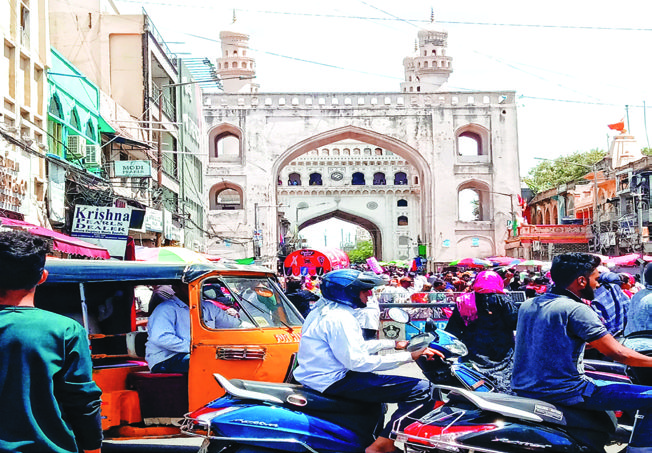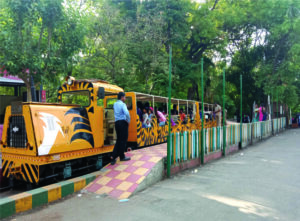
Beyond its reputation as the fifth biggest city in the country and being the repository of culture with Nizam’s affluent and influential history behind it, Hyderabad has travelled a long way. It is a majestic emblem of everything that symbolises urban trappings even as it wears its old-world charm on its sleeve. A fort, a museum, a film city, a zoological park, a sprawling lake – it has just about everything, but above all, it is also the country’s throbbing IT hub.
Text & Photo: Katie Sahiar
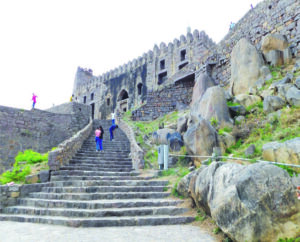
“The moving finger writes and having writ moves on…” Omar Khayam
As Hyderabad hurtles headlong towards megacity status the hand of destiny is clearly visible connecting the ancient to the modern. From the colossal fort of Golconda to the gargantuan Ramoji City, the genes of innovation have streamed forth.
Clap, clap, clap…
“You have to climb three hundred and eighty steps” warned our friend when we spoke of going to the Golconda Fort. Immediately, without climbing a single step we were breathless! But, visit the Fort we did and climbed all those steps as well, right to the top to look at the city of Hyderabad spread below.
Golconda Fort, was the precursor of Hyderabad city. Astonishingly, it originated as mud fort built by Rani Rudrama Devi in the eleventh century. A shepherd boy unearthed the statue of a deity on location and so it became Golla Kunda – Shepherd’s Hill in Telegu.
Rudrama Devi’s successor rebuilt it and thereafter, for the next sixty-two years the following Qutub Shahi Kings enlarged it into a massive edifice of stone and granite with three layers of defence, making it impenetrable and set it in a class apart with its extraordinary acoustic security system devised by Ibrahim Quli Qutb Shah. Such was the sound system, that a clap sounded at the base of the hill was clearly audible all the way up to the top of the hill. A clapping code was established to alert the king’s guards at the palace to distinguish between foe and friend. This unique security system kept the fort secure from attack and protected its cache of diamonds as it was an important trade centre on the diamond route. Even today, clapping is the USP of Golconda as the guides hanging around will eagerly explain.
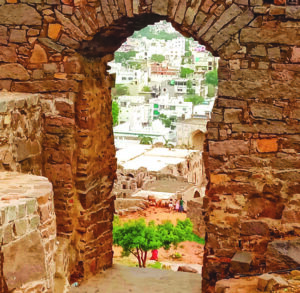
Patrons of art and architecture
Hyderabad, India’s fifth largest city, was founded in 1590 by Muhammed Quli the fourth Qutub Shahi king and the Qutub Shahi dynasty ruled this part of the Deccan from 1512 -1687 when the last of their line was defeated by Aurangzeb. After Aurangzeb’s death, Mughal control over this part of India declined and the Asaf Jah viceroys, placed here to protect Mughal interests, broke away to establish their own independent state and became Nizams.
Highly cultured, the Nizams were patrons of art and architecture. They excelled in building palaces, gardens and lakes that are spread all over the city. One of the most remarkable tributes to their love for beauty is the Salar Jung Museum.
This museum, situated on the southern bank of the river Musi was established in 1951 and owes its entire collection to the Salar Jung family, particularly Salar Jung III who relinquished his job as Prime Minister and for the next forty years devoted his life to collecting treasures of art and literature. He was famed as an art lover and his palace, the Dewan Deodi was thronged by sellers of art from all over the world. He continued to collect for forty years until he passed away on 2 March 1949 and the family decided to gift the entire collection to the nation. The collection in the form of a museum was opened to the public on 16th December, 1951 in Dewan Deodi, the home of Salar Jung but, in 1961, by an act of Parliament the Salar Jung Museum along with its library was declared an institution of national importance and was transferred to its current location.
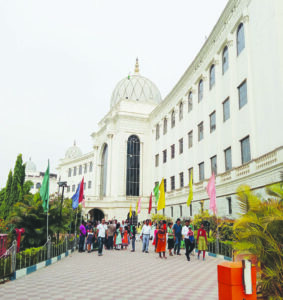
The entrance of this magnificent semi- circular building has elements of both the Eastern and Western architecture. It houses thirty- eight galleries spread over two floors and holds a one-man collection of over a million objects; forty-two thousand art objects, nine thousand manuscripts and sixty thousand printed books.
Almost in a daze we began our sojourn of the galleries containing paintings, manuscripts, weapons, daggers, sculptures, porcelain, furniture, chandeliers, clocks and innumerable other objects from all over the world. For a while we forgot the crowds while our cameras clicked constantly! Thoughtfully, the authorities have provided benches outside each gallery and we sank gratefully on to the benches from time to time to rest our aching feet. There was so much to cover that we forgot all about food and at the end of the day, when it was closing time were still engrossed with the European paintings and had to be chased out of the gallery!
Not to be defeated, we went back the next day determined not to miss out a single gallery. Thirty- eight galleries are open to the public, but many more on the third floor are locked and the fabulous Nizam’s jewels have been taken away by the government of India to rest in the vaults of the Reserve Bank of India.
Char Minar and Chowmalla Palace
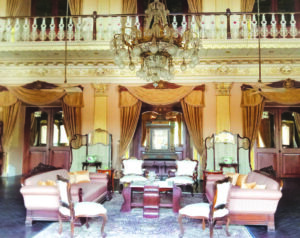
In the vicinity of the Salar Jung Museum lies the great bazaar of the Char Minar and the Chowmalla Palace, as part of the old walled city.
The Char Minar, or the four minarets is a massive triumphal arch built by Muhammad Quli Shah in 1591. This square structure with four pillars and intricate carving was built in thanks giving when plague ended in the city. It has a mosque on its top floor that is over five hundred years old. The Mecca Majid, adjacent to the Char Minar is one of the largest mosques in the world accommodating ten thousand people at a time, but the area is so congested that it is impossible to view the monuments. Avoiding the crowds, we crossed over from the Char Minar bazzar to the Chowmalla Palace.
Chowmalla Palace was the seat of power of the Asaf Jah Dynasty from 1720 – 1948. It was the official residence of the Nizams during their reign of Hyderabad and although converted into a museum the ownership of the palace still remains with the family. This palace was constructed by Nizam Ali Khan Asaf Jah II in 1769. He ordered four palaces to be built from which the name Chowmalla is derived.
Fortunately, it is set back from the overcrowded bazaar and stands in isolation amidst wide grounds that are serene and green. There is a fountain in the middle of the grounds which, although silent, is aesthetic. The four palaces on the outer lines form the quadrangle. Apart from the palaces, the most engaging exhibits were the numerous cars of the Nizam in large showcases.
A short distance from the Chowmalla Palace lies the Nizam’s Museum, also a residence at one time, though smaller. It now holds the last Nizam’s jubilee celebration gifts and the throne on which he sat during the celebration. The most unique object here was the wardrobe with hundred and twenty-four closets, each one meant to hold a new outfit for each day. No set of clothing was ever repeated and once worn, was given away. Marveling at this lifestyle we stepped into the hundred and fifty-year old, manually operated lift and descended from the wardrobe.
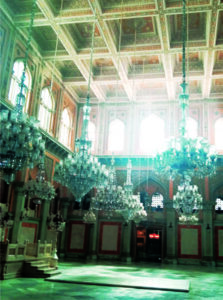
We had covered three museums during the day in the heat of June and by the evening we were exhausted. We headed back to the comfort of our temporary home, the Nizam Club to plan for the next day over dinner in their palatial dining room and when recovered from our exertions were ready for the zoo the next day.
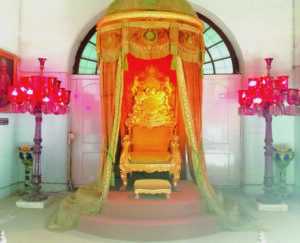
Nehru Zoological Park
The Nehru Zoological Park, sixteen kilometers away from the city, is one of the largest zoological parks in India, spread over an area of three hundred and eighty acres, housing almost one thousand five hundred species of birds, mammals and reptiles. It is the first zoo to have lodged animals in their zoological order. Several exotic animals have been bred here, as the park aims to conserve and breed endangered species, specially the wildlife of the Deccan.
The zoo is well organised and there are hop on-hop off electric vehicles plying all over. Ironically, the zoo authorities have gone to the trouble of having soundless electric vehicles, but are unable to tame the raucous hordes that invade it every day. Wide open spaces are accorded to the animals and these are protected with a wide moat distancing man and animal. The animals move about freely, as if in their own natural habitat and ignore the boisterous crowds most of the times, but some do react. We saw the Sun bear rear up on its hind legs and snarl at the crowd that was screaming at it.
Also a part of the zoo is the Mir Alam Tank built two hundred years ago, as a primary source of water for the city. It is remembered for its pure and sweet water that people carried away in containers.
Built during the reign of Asif Jah III it was named after Mir Alam Bahadur, the then prime minister who laid the foundation for it and was executed by a Frenchman, Michel Joachim Marie Raymond, a general in the Nizam’s army. Raymond, a person of exceptional sensitivity, felt deeply for the people. When the Nizam rewarded him for winning the Mysore war, he used the money to build the tank. He laid out the plans and commissioned the army to execute them; a piece of extraordinary engineering with twenty-one semi-circular masonry arches over an area of approximately one mile, forming a bund.

The ‘Heart of the World’
As the population of Hyderabad grew, so did their need for water and the Husain Sagar Lake was created to meet this demand.
Excavated in 1562, it covers an area of over five and a half acres and is positioned on the tributary of the River Musi that feeds it. A heart shaped lake, thirty-two feet deep, it is the largest artificial lake in Asia. A bund was built on its banks to control the outflow of water and until 1930, was used solely for water supply to the city.
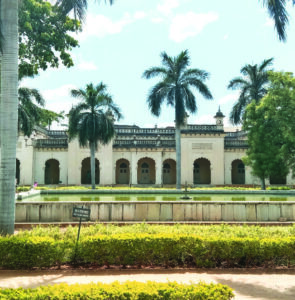
It was named the ‘Heart of the World’ by UNWTO – United Nations World Tourism Organisation on 27 September 2012 for being the largest heart shaped geographical feature on earth.
In the middle of the lake stands another monolithic monument – the standing Buddha. The brain child of the then chief minister, N.T Rama Rao, work on the project began in 1985 in Raigir, fifty kilometers from Hyderabad. It was completed in 1990 and this seventeen and a half meters high and three hundred and fifty-ton monolith was transported to Hyderabad and loaded onto a barge, to be installed upon the Rock of Gibraltar, a platform constructed in the middle of the lake, but fate intervened! An accident in mid-waters carried the statue to the bottom of the lake along with eight lives. There it remained for the next two years until in mid-1992 a Goanese company salvaged it from the lake, miraculously undamaged and raised it on its designated platform.
Hussain Sagar has a scenic setting, surrounded by vast gardens. The Sanjeeviah Park, the NTR Gardens and the Lumbini Park. We entered through one of the park gates, bought our entry ticket and walked in to a cacophony of sounds. Boisterous crowds were scattered around and to our utter astonishment were frolicking in the fountain set amidst the vast garden. It bothered us that children and adults jumped into the fountain’s pond fully clad, shoes and all and we walked away to the edge of the lake to get on a ferry and go out to the Rock of Gibraltar to bow to the Buddha up close.
The semi-circular periphery of the lake has been named the ‘necklace road’. It is the most happening part of the city with a boat club, restaurants, malls, entertainment parks and of course the famed Eat street. Paradise Restaurant being the most sought after for its acclaimed Biryani!
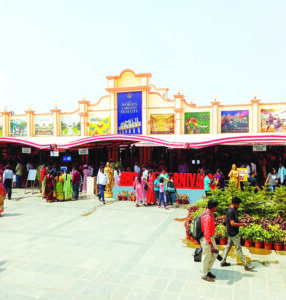
Visible from the lake, perched on a high hill is the Birla Mandir a recent landmark of the city, built by the Birlas in 1976. It is an edifice of white marble, located towards the southern end of the Hussain Sagar Lake and set atop a two hundred and eighty feet high hillock that stands on thirteen acres of land. It was consecrated by Swami Ranganathananda, the then head of the Ramakrishna Mission and is dedicated to Lord Vishnu in the form of Sri Venkateswara. Swami Ranganathananda had envisioned this temple as a place for meditation and in accordance with his wishes, the temple has no bells. The Rajagopuram is in the Southern architectural style while the tower over the main shrine, the Jagadananda Vimanam is in the Oriya style and the forty-two feet high sanctum sanctorum, the garbha gudi is a replica of the Venkateshwara temple at Tirumala.
The statue of Lord Venkateshwara, carved from a single granite piece eleven feet tall stands with a lotus canopy over His head. His consorts, Padmavati and Andal are worshipped in the adjoining shrines. The temple also has shrines dedicated to the Buddha, Shiva, Ganesh, Hanuman, Brahma, Lakshmi and Saibaba, signifying the unity of all religions.
Ramoji City, a visual treat
Sound has formed the connection through the ages. The genes of their ancestors who devised an acoustic security system five hundred years ago have flowed on and found their culmination in the reality of illusions created at Ramoji City. Moving ahead with its cutting edge VFX technology Ramoji City is the only place in India where multi-language filming happens with hi-tech technologies.
We signed up with Telangana Tourism to take a day trip to the film city which lies thirty kilometers away from the main city and is spread over one thousand, six hundred and sixty-six acres of land. The complex, built as a shooting location is now a frantically visited tourist haunt.
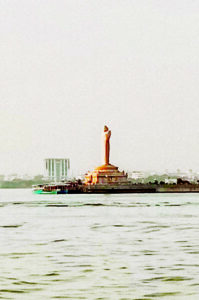
It was media baron Ramoji Rao’s dream project. He wanted to build a studio similar to the ones in Hollywood where it would be “Walk in with the script and walk out with the canned film”, according to a member of the film city’s administration, “The idea was to help filmmakers save time and production costs.”
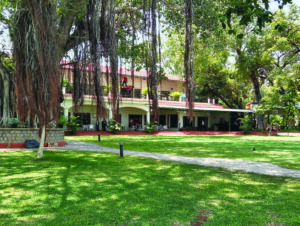
Bus and car loads of people descend upon Ramoji City every day in spite of its rather steep ticket price, but once in, each person becomes a Tollywood star of their own script, posing for selfies, imitating their favourite actors against fake houses, railway stations, planes and destinations they have seen in films! As the city is immense the crowds get dispersed, there is room to walk around, and buses to hop on when tired. Additional entertainment comes from the bus attendant who keeps up a running commentary in a very ‘filmy falsetto’. “Don’t go through the door of the palace you see or you will fall into the ditch behind it…samje na” …
The rides, the gardens, the butterfly park, the winged park, and the huge sets, particularly the ones from the blockbuster film Bahubali transports one into an illusory reality disconnected from time. It is easy to pass the day and as darkness descends, the magic of glitzy shows, dazzling lights and whirling rides takes over.
While nurturing the old, but embracing the new, Hyderabad has broken away from the old city with rapidity and has embraced within itself Hi Tech City and Ramoji City. Though the old rickshaws still ply, the preference is for the Metro Rail that zips through the city connecting far flung areas. Pearls endure, but it is no longer the ‘city of pearls’. Hi Tech has taken over and the city pursues a new path, but as the poet says: “Though much is taken, much abides”.
 Widely travelled the author now heads the destination research division of Exotica Traveller. She is also an environmentalist and the author of four coffee table books on nature and also contributes articles to newspapers and magazines.
Widely travelled the author now heads the destination research division of Exotica Traveller. She is also an environmentalist and the author of four coffee table books on nature and also contributes articles to newspapers and magazines.

